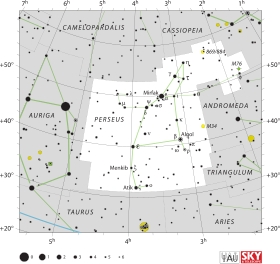40 Persei
| Observation data Epoch J2000 Equinox J2000 | |
|---|---|
| Constellation | Perseus |
| Right ascension | 03h 42m 22.64555s[1] |
| Declination | 33° 57′ 54.0893″[1] |
| Apparent magnitude (V) | 4.97[2] |
| Characteristics | |
| Spectral type | B0.5V[3] + A1Vn[4] |
| U−B color index | −0.84[5] |
| B−V color index | +0.00[5] |
| Astrometry | |
| Radial velocity (Rv) | +22.00[6] km/s |
| Proper motion (μ) | RA: +2.71[1] mas/yr Dec.: −5.91[1] mas/yr |
| Parallax (π) | 3.09 ± 0.21 mas[1] |
| Distance | 1,060 ± 70 ly (320 ± 20 pc) |
| Absolute magnitude (MV) | −2.26[2] |
| Details | |
| 40 Per A | |
| Mass | 12.5[7] M☉ |
| Luminosity | 936[2] L☉ |
| Surface gravity (log g) | 4.36[8] cgs |
| Temperature | 29,330[9] K |
| Metallicity [Fe/H] | −0.43[2] dex |
| Rotational velocity (v sin i) | 10[10] km/s |
| Age | 7.2[11] Myr |
| Other designations | |
| Database references | |
| SIMBAD | data |
40 Persei is a wide binary star[13] system in the northern constellation of Perseus. It has the Bayer designation ο Persei, while 40 Persei is the Flamsteed designation. The system is visible to the naked eye as a faint, blue-white hued point of light with an apparent visual magnitude of 4.97.[2] It is located approximately 1060 light years away from the Sun based on parallax,[1] and is drifting further away with a radial velocity of +22 km/s.[6] The system is a member of the Perseus OB2 association of co-moving stars.[14]
The primary component is a massive B-type main-sequence star with a stellar classification of B0.5V.[3] It is about 7.2[11] million years old and has a very low projected rotational velocity for an early B-type star,[15] measured at 10 km/s.[10] This star has 12.5[7] times the mass of the Sun and is radiating 936[2] times the Sun's luminosity from its photosphere at an effective temperature of 29,330 K.[9] The companion is magnitude 10.04, A-type main-sequence star with a class of A1Vn, and is located at an angular separation of 19.8″ from the primary.[4]
References
- ^ a b c d e f Van Leeuwen, F. (2007). "Validation of the new Hipparcos reduction". Astronomy and Astrophysics. 474 (2): 653–664. arXiv:0708.1752. Bibcode:2007A&A...474..653V. doi:10.1051/0004-6361:20078357. S2CID 18759600. Vizier catalog entry
- ^ a b c d e f Anderson, E.; Francis, Ch. (2012). "XHIP: An extended hipparcos compilation". Astronomy Letters. 38 (5): 331. arXiv:1108.4971. Bibcode:2012AstL...38..331A. doi:10.1134/S1063773712050015. S2CID 119257644. Vizier catalog entry
- ^ a b Hoffleit, D.; Warren, W. H. (1995). "VizieR Online Data Catalog: Bright Star Catalogue, 5th Revised Ed. (Hoffleit+, 1991)". VizieR On-line Data Catalog: V/50. Originally Published in: 1964BS....C......0H. 5050. Bibcode:1995yCat.5050....0H.
- ^ a b Mason, Brian D.; et al. (2001). "The 2001 US Naval Observatory Double Star CD-ROM. I. The Washington Double Star Catalog". The Astronomical Journal. 122 (6): 3466. Bibcode:2001AJ....122.3466M. doi:10.1086/323920. Vizier catalog entry
- ^ a b Mallama, A. (2014). "Sloan Magnitudes for the Brightest Stars". The Journal of the American Association of Variable Star Observers. 42 (2): 443. Bibcode:2014JAVSO..42..443M.Vizier catalog entry
- ^ a b Gontcharov, G. A. (2006). "Pulkovo Compilation of Radial Velocities for 35 495 Hipparcos stars in a common system". Astronomy Letters. 32 (11): 759–771. arXiv:1606.08053. Bibcode:2006AstL...32..759G. doi:10.1134/S1063773706110065. S2CID 119231169.
- ^ a b Tetzlaff, N.; et al. (2011). "A catalogue of young runaway Hipparcos stars within 3 kpc from the Sun". Monthly Notices of the Royal Astronomical Society. 410 (1): 190–200. arXiv:1007.4883. Bibcode:2011MNRAS.410..190T. doi:10.1111/j.1365-2966.2010.17434.x. S2CID 118629873.
{{cite journal}}: CS1 maint: unflagged free DOI (link) Vizier catalog entry - ^ Soubiran, Caroline; et al. (2016). "The PASTEL catalogue: 2016 version". Astronomy & Astrophysics. 591: A118. arXiv:1605.07384. Bibcode:2016A&A...591A.118S. doi:10.1051/0004-6361/201628497. S2CID 119258214.
- ^ a b Zorec, J.; et al. (2009). "Fundamental parameters of B supergiants from the BCD system". Astronomy and Astrophysics. 501: 297–320. arXiv:0903.5134. Bibcode:2009A&A...501..297Z. doi:10.1051/0004-6361/200811147. S2CID 14969137.
- ^ a b Abt, Helmut A.; et al. (2002). "Rotational Velocities of B Stars". The Astrophysical Journal. 573 (1): 359–365. Bibcode:2002ApJ...573..359A. doi:10.1086/340590.
- ^ a b Seyfert, C. K.; et al. (July 1960). "A Study of the II Persei Association". Astrophysical Journal. 132: 58. Bibcode:1960ApJ...132...58S. doi:10.1086/146900.
- ^ "40 Per". SIMBAD. Centre de données astronomiques de Strasbourg. Retrieved 2019-07-18.
- ^ Eggleton, P. P.; Tokovinin, A. A. (September 2008). "A catalogue of multiplicity among bright stellar systems". Monthly Notices of the Royal Astronomical Society. 389 (2): 869–879. arXiv:0806.2878. Bibcode:2008MNRAS.389..869E. doi:10.1111/j.1365-2966.2008.13596.x. S2CID 14878976.
{{cite journal}}: CS1 maint: unflagged free DOI (link) - ^ Lesh, J. R. (September 1969). "Internal motions in the associations II Per and I Lac". Astronomical Journal. 74: 891–898. Bibcode:1969AJ.....74..891L. doi:10.1086/110878.
- ^ Guthrie, B. N. G. (September 1984). "The rotation of early B-type stars and the problem of star formation". Monthly Notices of the Royal Astronomical Society. 210: 159–171. Bibcode:1984MNRAS.210..159G. doi:10.1093/mnras/210.1.159.

